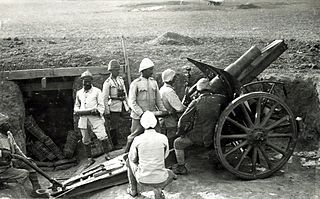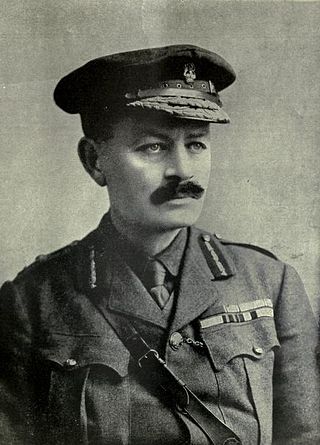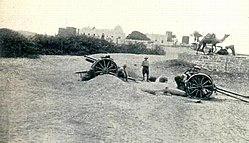
The history of Yemen describes the cultures, events, and peoples of what is one of the oldest centers of civilization in the Near East. Its relatively fertile land and adequate rainfall in a moister climate helped sustain a stable population, a feature recognized by the ancient Greek geographer Ptolemy, who described Yemen as Eudaimon Arabia meaning "fortunate Arabia" or "Happy Arabia". Yemenis had developed the South Arabian alphabet by the 12th to 8th centuries BC, which explains why most historians date all of the ancient Yemeni kingdoms to that era.

The Yemeni Armed Forces are the military forces of the Republic of Yemen. They include the Yemeni Army, Yemeni Navy and the Yemeni Air Force. The capital of the country, Sana’a is where the military is headquartered. Per the constitution of Yemen, the President of Yemen serves as the commander-in-chief.

Aden is a port city located in Yemen in the southern part of the Arabian peninsula, positioned near the eastern approach to the Red Sea. It is situated approximately 170 km east of the Bab-el-Mandeb strait and north of the Gulf of Aden. With its strategic location on the coastline, Aden serves as a gateway between the Red Sea and the Arabian Sea, making it a crucial maritime hub connecting Africa, Asia, and the Middle East. As of 2023, Aden City has a population of approximately 1,080,000 residents, making it one of the largest cities in Yemen.

The Arab Revolt or the Great Arab Revolt was an armed uprising by the Hashemite-led Arabs of the Hejaz against the Ottoman Empire amidst the Middle Eastern theatre of World War I.

The Sinai and Palestine campaign was part of the Middle Eastern theatre of World War I, taking place between January 1915 and October 1918. The British Empire, the French Third Republic, and the Kingdom of Italy fought alongside the Arab Revolt in opposition to the Ottoman Empire, the German Empire, and the Austro-Hungarian Empire. It started with an Ottoman attempt at raiding the Suez Canal in 1915 and ended with the Armistice of Mudros in 1918, leading to the cession of Ottoman Syria.

Lahij or Lahej, formerly called Al-Hawtah, is a city and an area located between Ta'izz and Aden in Yemen. From the 18th to the 20th century, its rulers were of the Abdali branch of the Al-Sallami tribe who trace their lineage to one of the 10 tribes of Yaffa called Kalad. Lahij was the capital city of the Sultanate of Lahej, a protectorate of the British Empire until 1967, when the sultan was expelled and the city became a part of People's Republic of South Yemen. Now it is part of the Republic of Yemen.

The Aden Protectorate was a British protectorate in southern Arabia. The protectorate evolved in the hinterland of the port of Aden and in the Hadhramaut after the conquest of Aden by the Bombay Presidency of British India in January 1839, and which continued until the 1960s. In 1940, it was divided for administrative purposes into the Western Protectorate and the Eastern Protectorate. The territory now forms part of the Republic of Yemen.

Aden Colony, also the Colony of Aden, located in the south of contemporary Yemen, was a crown colony of the United Kingdom from 1937 to 1963. It consisted of the port of Aden and its immediate surroundings.

Dhala or Dhali`, Amiri, or the Emirate of Dhala was a state in the British Aden Protectorate, the Federation of Arab Emirates of the South, and its successor, the Federation of South Arabia. Its capital was Dhala.

Kamaran Island is the largest Yemeni island in the Red Sea. The 108 km2 (42 sq mi) island is 18 km (11 mi) long and 7 km (4.3 mi) wide and is strategically located at the southern end of the Red Sea. It is a "shelf island" located in the shallow waters of the Arabian peninsula's continental shelf with coral reefs surrounding three sides of the island. The population numbers 2,200.

Lahej, the Sultanate of Lahej, or, sometimes, the Abdali Sultanate, was a Sheikdom based in Lahij in Southern Arabia. The Sultanate became self-ruling in 1728 and gained independence in 1740. In 1839, the Sultanate became part of the Aden Protectorate of the British Empire, though nominally the 'Abdali Sultan retained his status. The Aden Protectorate was briefly ruled again by the Ottomans during World War I, but regained by the British and absorbed into Federation of South Arabia in 1963. The 'Abdali dynasty was officially abolished in 1967, with the proclamation of South Yemen.

The Mahra Sultanate, known in its later years as the Mahra State of Qishn and Socotra or sometimes the Mahra Sultanate of Ghayda and Socotra was a sultanate that included the historical region of Mahra and the Guardafui Channel island of Socotra in what is now eastern Yemen. It was ruled by the Banu Afrar dynasty for most of its history.

The Saudi–Yemeni War was a war between Saudi Arabia and the Kingdom of Yemen in 1934.
The siege of Medina lasted from 10 June 1916 to 10 January 1919, when Hejazi Arab rebels surrounded the Islamic holy city, which was then under the control of the Ottoman Empire.

The Unification of Saudi Arabia was a military and political campaign in which the various tribes, sheikhdoms, city-states, emirates, and kingdoms of most of the central Arabian Peninsula were conquered by the House of Saud, or Al Saud. Unification started in 1902 and continued until 1932, when the Kingdom of Saudi Arabia was proclaimed under the leadership of Abdulaziz, known in the West as Ibn Saud, creating what is sometimes referred to as the Third Saudi State, to differentiate it from the Emirate of Diriyah, the First Saudi State and the Emirate of Nejd, the Second Saudi State, also House of Saud states.

The Aden Protectorate Levies (APL) was a military force recruited from indigenous tribal populations, for the local defence of the Aden Protectorate under British rule. The Levies were drawn from all parts of the Protectorate and were armed, trained and officered by the Indian Army, Royal Air Force and British Army at various stages in the history of the force. They used the Lahej emblem of crossed jambiyah as their badge.

The Force in Egypt was a British Army formation established in August 1914 to administer garrisoning armed forces in Egypt at the beginning of the First World War. The force had the objective of protecting the Suez Canal and was originally commanded by Major General Julian Byng, but he was replaced by General J. Maxwell, who took command on 8 September 1914. Initially, the main threat to the Suez came from Germany and throughout the early months several of the force's elements were sent to Europe to take part in the fighting on the Western Front. On 5 November 1914, Britain and France declared war on the Ottoman Empire, after which the Force in Egypt faced a direct threat from Ottoman forces, which was realised in February 1915 with a raid on the Suez Canal. This threat remained until 1916 when the British forces went on the offensive.

The Baidah Sultanate was a state in South Arabia.

The invasion of Cheikh Said was a part of the campaigns by the Ottomans to take Aden, a British crown colony. It is a British offensive led by H. V. Cox to destroy Ottoman works, wells, and armaments they have there on the 10th of November 1914. It resulted in Ottoman retreat and total British victory by the next day.

The Battle of Ad-Dakim took place on July 3, 1915, in the Sultanate of Lahej, in which the Yemeni-Ottoman forces defeated the forces of the Sultan of the Sultanate of Lahej, Ali bin Ahmed, who were loyal to the British. They entered Lahej, and its sultan, Ali bin Ahmed Al-Abdali, withdrew from it to Aden, where he was assassinated by firing squad.






















